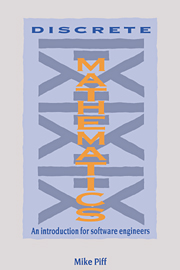8 - Abstract algebra
Published online by Cambridge University Press: 05 June 2012
Summary
Introduction
The types of mappings we have met in Chapter 5 have mostly been the sort where the domain has been simple, that is, not a cartesian product of sets. There is a type of mapping which arises frequently in applications, and it is exemplified by the function f : ℝ2 → ℝ given by f(x,y) = x + y. Such mappings are called binary operations, and much effort has been expended during the last two centuries on studying their properties.
A seemingly unrelated problem is that of finding a mathematical specification for strings in programming languages. Strings and binary operations are not all that different when we look at their formalism, and the theory we shall develop will also be able to model stacks, queues, and other related structures.
Finally, we shall look at the way in which programming languages are specified, and shall develop a notation for working with their syntax. We shall investigate the way we can simplify the structure of a language, and how to write a program to recognize valid statements in the language.
The pace of this chapter will be brisker than previous ones. We shall leave more details for the student to fill in. It is hoped that by now the student has acquired enough mathematical confidence to be able to do this.
- Type
- Chapter
- Information
- Discrete MathematicsAn Introduction for Software Engineers, pp. 197 - 239Publisher: Cambridge University PressPrint publication year: 1991



